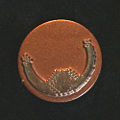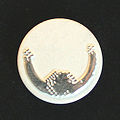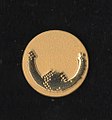German dance badge
The German Dance Badge (DTA) is an award that has been given to dancers by the General German Dance Teachers Association since 1968 . In addition to the world dance needle , which is usually awarded after completing an advanced course, there is the German dance badge in bronze, silver, gold, gold star and super gold star rank I, II and III. Applicants are tested in four to six dances, depending on the level. A trained dance teacher acts as an examiner and assesses the dances selected from the five standard dances and the five Latin American dances .
| classical standard dances |
classical latin dances |
|---|---|
| Slow waltz | Cha-Cha-Cha |
| Viennese waltz | rumba |
| Slowfox | Jive |
| tango | samba |
| Quickstep / Foxtrot | Paso Doble |
The prerequisite for choosing the dances are the dances taught in the dance course, which usually consist of the five Latin or standard dances. Discofox , Salsa , Rock 'n' Roll , Mambo , Lambada or the like are only admitted to the examination in exceptional cases and only if they were part of the course program.
The German dance badge is an award for practice-related ballroom dancing and is therefore neither in competition nor dependent on the German dance sport badge , which gives dance athletes the opportunity to measure their skills.
conditions
- Bronze - The applicant is tested in four dances of his choice.
- Silver - The admission requirement is the bronze dance badge. The applicant chooses three standard dances (except slow fox) and two Latin American dances or two standard (except slow fox) and three Latin American dances.
- Gold - For the gold dance badge you need the silver one first. The applicant must choose three standard dances (except Slowfox) and three Latin American dances.
- Goldstar - For the Goldstar dance badge you first need the golden dance badge. The applicant has to choose four dances, the examiner gives two dances. A total of three standard dances and three Latin American dances must be danced. The next badge can only be taken one year after the Goldstar badge.
- Super Goldstar Rank I, II and III - For the dance badge Super Goldstar Rank I you first need the Goldstar badge and from rank II the previous rank. In these exams, all dances are selected by the examiner. There are three standard dances and three Latin American dances to be danced. Only one Super Goldstar badge can be used within a calendar year.
Evaluation criteria
In every medal test, tact, posture and footwork are assessed. In bronze and silver exams, these are the only criteria. From gold on, there are arm lines, rhythm and dance performance.
Each dance can be rated with a maximum of 15 points. This results in theoretical maximum points of 60 (bronze), 75 (silver) and 90 (from gold). The following ratings apply:
| rating | bronze | silver | from gold |
|---|---|---|---|
| failed | 0-29.5 | 0-39.5 | 0-44.5 |
| passed | 30-44.5 | 40-54.5 | 45-69.5 |
| well done | 45-54.5 | 55-69.5 | 70-84.5 |
| very well passed | 55-59.5 | 70-74.5 | 85-89.5 |
| passed with honors | 60 | 75 | 90 |








